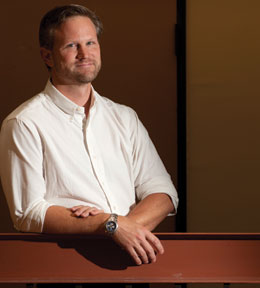Volume 30 · Number 4 · Summer 2013
The young and the inventive: Nicholas Curro

Nicholas Curro
(Photo: Gregory Urquiaga/UC Davis
Nicholas Curro, professor of physics
Education: Ph.D., University of Illinois at Urbana-Champaign, 1998; B.S. Rice University, 1993
Specialty: Using nuclear magnetic resonance techniques to study the properties of superconductors, which conduct electricity without resistance
Nicholas Curro has been using powerful magnets to explore the properties of new superconducting materials, with the ultimate, long-term goal of developing superconductors that will work at room temperatures and transform many of the processes that govern our daily lives.
Today, about 8 percent of the electricity generated in the United States is lost in transmission from power plants to users along miles of copper cables. “It’s equivalent to several power stations running full steam ahead and all that power being wasted,” Curro says. “If we could convert cables to superconducting cables you’d save that 8 percent. It’s exactly lossless. There is zero resistance.”
To the layperson, superconductors appear to exhibit magical properties. Curro and a graduate student take a small disk, several centimeters in diameter, made up of a ceramic atrium barium copper oxygen compound. They pour liquid nitrogen, kept at a temperature of 77 degrees Kelvin, or minus 321 degrees Fahrenheit, over the disk. As the nitrogen hits air, it immediately vaporizes — again and again for several minutes, and then they place a magnet above it. The barium tab, its superconductor properties activated, sends spontaneous currents out, with the electrons pairing off and swarming around the edge of the material, forming a strong enough force to overcome gravity. The magnet, trapped in this force, which suffers no leakage or energy loss in this state, stays suspended above the tab, rotating like a widget in a scene from Star Wars. It has become a frictionless ball bearing, and will remain so for as long as the barium tab stays at that temperature.
In the center of the lab is a huge magnet, far more powerful than those in an MRI machine. It is kept permanently chilled in a bath of liquid nitrogen and helium, getting down to 4 degrees Kelvin, or minus 452 degrees Fahrenheit. Kept at that temperature permanently, it operates as a permanent superconductor.
Discovery of superconductors is, Curro said, largely a process of trial and error. Through tinkering with new material designs, physicists know, after the fact, if a material exhibits certain properties, that they have discovered a superconductor. What they don’t know is how to predict upfront what classes of materials will have these properties. To a large extent, it’s a complex game of blind man’s bluff. Tinker until one stumbles upon a superconductor, work out what sets of characteristics make it a superconductor and at what temperatures, and then try to improve on the original by adding in new materials that have been of use in past superconductor work.
Curro and his team are currently looking at a new class of materials that are based around iron and arsenic compounds, which the accumulated evidence suggests might allow for superconductivity at warmer temperatures. The Holy Grail is to eventually develop materials that behave as superconductors even at room temperature. Get close to that goal, and superconductors will become ubiquitous parts of everyday life: frictionless ball-bearings to be used in cars and in military equipment, frictionless axels used in wind turbines, trains levitated by superconducting tracks, control mechanisms within electric grids to prevent power spikes, very precise electronic filters to allow more cell phone carriers in a given frequency range.
“The dream,” said Curro, who worked at Los Alamos National Laboratory as a postdoctoral fellow from 1998 to 2000, “is we’ll be able to find a material that is a more robust conducting material.” A lot of researchers, he says, “are playing in the sand box, mixing materials to try to make something new. We’re playing with different kinds of materials in the periodic table, trying to find interesting materials where there’s something unusual happening. Sometimes we get lucky and sometimes we don’t.”
Back to The Young and the Inventive
